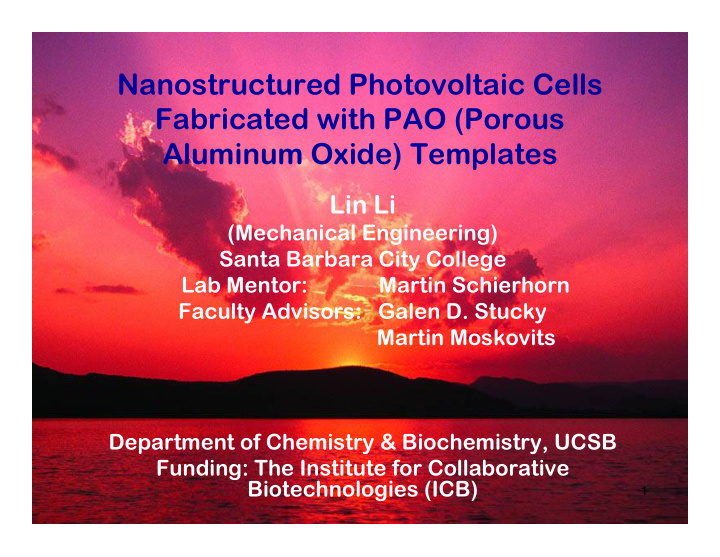



Nanostructured Photovoltaic Cells Fabricated with PAO (Porous Aluminum Oxide) Templates Lin Li (Mechanical Engineering) Santa Barbara City College Lab Mentor: Martin Schierhorn Faculty Advisors: Galen D. Stucky Martin Moskovits Department of Chemistry & Biochemistry, UCSB Funding: The Institute for Collaborative Biotechnologies (ICB) 1
Application of Nanostructured Photovoltaic Cells Fabricated with PAO Templates 1. Energy Source: •The diagram of solar power the (free and nanostructured renewable) photovoltaic cells Photons 2. Development of Materials: flexible, cost- effective, easily processable (such as polymers) ( Interface of two different materials) 2
Procedure of Making CdSe Cells CdSe Nanorods PAO 1 2 3 4 Metal layer V 5 6 Copper Strip 3
1 2 3 Goals 4 V 5 6 decreased recombination Find optimal kinetics thickness of TiO 2 Try out different metal limit the Schottky barrier layers instead of gold issues (Ti or Ni) Play around with Increase the different dimensions absorption of photons of nanorodes 4
Preparation of PAO Templates • First Anodization • Second Anodization 1. Condition: 1. Same conditions for 12 hours --- 0.3 M oxalic acid --- results: pores of ~80 --- 15 degree C micrometers long by ~40 nm in --- 40 Volts for 3 hours diameter 2. Removed with H 3 PO 4 / H 2 CrO 4 at 65 degree C for 2 hours (in the oven) 1 2 5 Template after 2nd Anodization
CdSe Nanorods under the SEM CdSe nanorods TiO 2 layer Metal layer (ITO layer) 1 2 3 4 V 5 6 6
Electrochemical Photovoltaic Characteristics of CdSe Efficiency = ( V oc * I sc * FF ) ( 100mW/cm 2 ) • Voc – open circuit voltage • Isc – short circuit current • FF – fill factor IV characteristics 15.0µ with TiO2 + Au 10.0µ Isc Isc Au CdSe samples with TiO2 + ITO Current (A) 5.0µ 0.0 Keithley SMU Voc Voc -5.0µ -10.0µ -15.0µ -0.3 -0.2 -0.1 0.0 7 Potential (V) vs. Pt Equipment for testing
Summary • Conclusions 1. IV Curve shows that TiO 2 layer leads to better efficiency than the one without it 2. TiO 2 layer decreases recombination kinetics • Future Plans P3HT polymer 1. Combine P3HT polymer with CdSe half solar cells 2. Substitute with new polymers • Picture comes from: 8 Picture comes from: www.bee.qut.edu.au/.../projects/photovoltaics
Acknowledgements • Mentor: Martin Schierhorn • Adviser: Galen D. Stucky Martin Moskovits • Professors: Nick Arnold & Dr. Young • Funding Source: The Institute for Collaborative Biotechnologies (ICB) • Summer research program: INSET 9
10 THANK YOU !
Diagrams of Anodization 2nd Anodization 5_16 18 16 0.13 Tem p 14 current Temperature (C) 12 Current (A) 0.12 10 8 0.11 6 4 0.10 2 0 0 2 4 6 8 10 12 tim e (h) Time vs. Temperature & Time vs. Current 11 Equipment for Anodization
PAO Templates • PAO Templates (With gold layer) (With ITO layer) 12
Recommend
More recommend